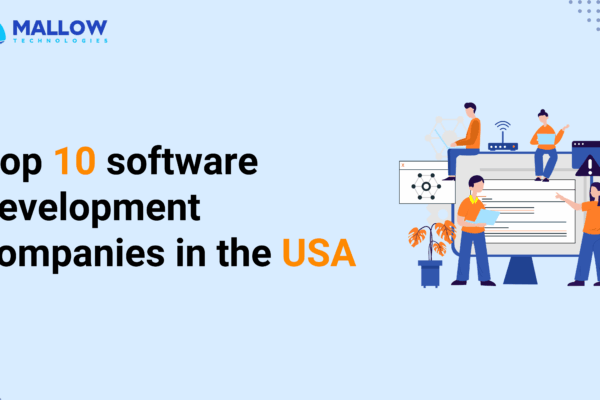Any time you’re considering hiring a web and mobile application development team, cost is one of the big things on your mind. And it’s likely that you’re getting different numbers from different application development companies, which can be confusing and even frustrating.
We’ve seen that when companies don’t understand how application development companies determine pricing they can find themselves paying more or being stuck with a team that isn’t a good fit. By understanding the elements contributing to the final cost, you, as a business owner, can better judge whether the cost proposed by your development team is reasonable.
At Mallow, we understand the significance of application owners comprehending the factors that influence development costs. Throughout our years in operation, our steadfast commitment to transparent business practices has consistently been the main factor motivating our clients to choose our services repeatedly.
By reading this article, you will understand the factors that application development companies consider when determining service charges.
Why is understanding the development team’s cost factors important?
It is crucial for you, as an application owner, to understand how software development companies determine the cost they charge. This understanding empowers you to make decisions with greater knowledge and negotiate better deals for developing your applications. By understanding the factors that influence the cost, you can assess whether the quote you receive is reasonable and compare it with other offers from other companies. You can also communicate your budget constraints and preferences to the development company more effectively and avoid any misunderstandings or surprises regarding the cost.
Understanding the cost structure helps application owners better organise your resources and prepare for future expenses.
The factors that influence the cost charged by application development companies can vary depending on the project’s complexity, requirements, and the development company’s location and expertise.
For easier understanding, let us classify the determining factors into two types:
1.
Requirement-dependent
2.
Development team-specific
Factors based on your application requirements
The overall cost of a project can be influenced by several factors, including but not limited to the complexity of the application, the necessary features and functionalities, the technology stack and development platform, the design and user experience (UX) demands, as well as the integration with other systems or APIs.
Therefore, it is crucial to clearly define the application’s requirements and prioritise the essential features and functionality to meet the project goals. Below mentioned are the details on how and in what ways the factors impact your application’s development cost;
1. Project scope and complexity
The more extensive and complex the requirements, the higher the development cost. This can include additional development time, specialised expertise, and testing and debugging efforts. We recommend you start with a Minimum Viable Product (MVP) when developing your applications.
From a budget perspective, opting for an MVP allows you to minimise initial investment by focusing on essential features and functionalities. This approach ensures that financial resources are allocated efficiently, reducing the risk of overspending. By involving users in the development process, you can refine and enhance the application based on real-world usage and avoid potentially costly mistakes.
2. Expertise that your application demands
Choosing a team with higher levels of expertise, such as experienced senior developers and domain specialists, usually comes with a higher cost. However, this investment can lead to faster development, better code quality, and fewer errors, ultimately reducing the overall cost in the long run.
On the other hand, opting for less experienced or junior developers may lower the upfront cost but could result in longer development timelines, increased likelihood of errors, and potentially higher maintenance costs.
It’s essential to strike a balance between expertise and cost. Depending on the complexity and requirements of the application, a mix of different expertise levels could be a cost-effective solution. It may be wise to allocate a budget for highly skilled experts for critical components or complex features. In contrast, other less critical areas can be handled by junior developers under proper supervision.
3. Timeframe and deadline requirements
The timeframe and requirement details of an application can significantly impact the overall development cost. The timeframe determines the amount of time available for development, and a shorter timeframe often requires a more intensive and focused effort, which may increase costs. Tight deadlines can require additional resources or expedited work, potentially resulting in higher expenses.
Well-defined and specific requirements allow for smoother development, accurate estimation, and efficient allocation of resources. In contrast, vague or constantly changing requirements can lead to scope creep, rework, and delays, all of which can escalate costs.
4. Technology stack and tools
The availability and licensing costs of specific technologies and tools can impact the budget. Some frameworks or development environments may require purchasing licences or subscriptions, increasing the upfront expenses. Compatibility and integration with existing systems also play a role.

If the chosen tech stack seamlessly integrates with your existing infrastructure and tools, it can reduce development efforts and costs associated with integration work.
5. Design and user experience (UX) requirements
Developing an aesthetically pleasing and user-friendly application requires a lot of effort and expertise, and the more complex the design and UI/UX requirements, the higher the cost will likely be.
A well-designed and intuitive user interface requires careful planning, research, and design iterations. This involves conducting user studies, creating wireframes and prototypes, and implementing user feedback to refine the design. The complexity of the design, the number of screens or pages, and the level of customisation required all contribute to the development cost.
It adds to the complexity and cost if the application needs to be responsive and optimised for multiple devices and platforms. The development team may need to include UI/UX designers, interaction designers, and front-end developers who specialise in creating visually appealing and user-friendly interfaces.
6. Integration with other systems or APIs
Integrating an application with other systems or APIs can significantly affect the overall development cost. Integration requires understanding the functionality and specifications of the external systems or APIs and designing the application’s architecture to accommodate them. If the integration involves complex business logic, data synchronisation, or real-time communication, it may require additional development efforts.
The development team needs to spend time on API documentation, testing, and troubleshooting to ensure seamless integration. In some cases, licensing or subscription fees may be involved when integrating with third-party systems or using premium APIs, which can contribute to the overall cost. The more extensive and intricate the integration requirements, the more time, expertise, and resources will be needed, thereby impacting the development cost.
7. Maintenance and support requirements
Considering the maintenance and support requirements during the development phase is crucial in determining the overall cost. Ongoing maintenance and support ensure the application remains functional, secure, and up-to-date with the latest technologies and security patches. The cost of maintenance and support activities, such as bug fixes, performance optimisations, feature enhancements, and user support, should be factored into the development budget.
Some technologies have active developer communities and frequent updates, ensuring long-term support and reducing the risk of technical debt. This helps in avoiding future expenses for resolving compatibility issues or security vulnerabilities.

Complex applications with larger codebases or those requiring frequent updates and improvements will incur higher maintenance costs. Applications also require 24/7 technical support or have strict service-level agreements (SLAs), it may require dedicated resources or third-party services, which can increase the overall cost. Planning for long-term maintenance and support requirements upfront helps in accurately estimating the development cost.
8. Security and compliance requirements
Ensuring data security and compliance with regulations such as GDPR or HIPAA involves implementing robust security measures, encryption, access controls, and regular security audits. These additional security requirements can require specialised expertise, increased development time, and potentially the involvement of security consultants or auditors, all of which contribute to the development cost.
9. Data handling
Determining the appropriate database technology, and scalability needs can influence the overall cost. If the application deals with large amounts of data, complex data relationships, or requires real-time data processing, it may necessitate advanced database architectures or distributed systems, which can increase development efforts and costs.
Your application development team’s specific factors
The overall development cost of an application can vary based on several development team-specific factors. It is true that different application development companies may charge different prices for their services, and this discrepancy is not solely based on numbers but also on various considerations within the business operations.
Companies that follow structured development frameworks such as Agile or Scrum tend to have better project management practices, resulting in more accurate estimations and streamlined development. This, in turn, can lead to more predictable costs. On the other hand, companies with less organised or ad-hoc development processes may encounter delays, rework, and unexpected costs.
The cost charged by a development company should be assessed in conjunction with their expertise, development processes, resources, and reputation. A justified cost should be based on a combination of these factors, ensuring that the development team can deliver a high-quality application within the specified budget and timeline. You need to evaluate these factors when choosing an application development company.
Below mentioned are the details about some of the development team-specific factors that impact your development costs.
1. Recruitment process of application development companies
Efficient and effective recruitment processes help hire skilled and experienced developers who can deliver high-quality solutions. A thorough recruitment process involves screening, interviewing, and assessing candidates to ensure they possess technical expertise, domain knowledge, and problem-solving skills. The development company’s rates reflect the cost of attracting, evaluating, and hiring top talent.
A robust recruitment process helps build a reliable and capable development team, reducing risk of project delays, errors, and rework risk. Hiring skilled professionals who can efficiently execute tasks and contribute to the project’s success helps optimise development time and minimise costs.
On the other hand, if the recruitment process is inefficient or lacks proper screening mechanisms, it can lead to the hiring of inexperienced or inadequate developers. This can result in lower productivity, higher error rates, and the need for extensive supervision and rework, which negatively impact the development cost.
2. Continuous training of the application development companies
As technology evolves, it is important for employees to stay up-to-date with the latest tools, techniques, and programming languages. This requires training, which can be costly in time and money.
But, the benefits of continuous training can outweigh the costs. When well-trained, employees can work more efficiently and effectively, resulting in faster development times and higher-quality products. This can ultimately reduce the overall development cost for the software company, as projects are completed more quickly and with fewer errors or setbacks.
3. Efficient Business process
A well-organised team with efficient processes can optimise resource allocation, minimise wastage, and enhance productivity. Effective project management practices, such as setting clear goals, breaking down tasks, and assigning responsibilities, ensure the development process progresses smoothly and on schedule. Clear communication channels and regular progress updates help identify and address issues promptly, preventing costly delays or misunderstandings.
Streamlined workflows and standardised development practices enable the team to work more efficiently, reducing the time required for coding, testing, and debugging. This not only accelerates the development timeline but also minimises the need for rework and revisions, ultimately saving costs. By focusing on efficient business processes, development teams can optimise resources, increase productivity, and deliver applications within the specified budget, thus positively impacting the overall development cost.
4. Location of the development team
The location of a development team can significantly impact the overall development cost of an application. Development teams based in regions with higher costs of living, such as certain cities in the United States or Western Europe, tend to charge higher rates due to higher wages and operational expenses. On the other hand, teams located in regions with lower costs of living, such as Eastern Europe Southern part of Asia, charge comparatively less.
The cost difference can be attributed to variations in wages, taxes, infrastructure costs, and market competitiveness. Therefore, choosing a development team’s location can influence the development cost, allowing you to select an option that aligns with your budget and cost expectations.
5. Resource management
Effective resource management ensures that the right team members with the appropriate skills and expertise are assigned to the project at the right time. One aspect of resource management is effectively managing benches, which refers to optimising the allocation of team members when they are not actively working on a project.
By strategically managing the benches, application development companies can minimise downtime and idle resources. This involves analysing the availability and skills of team members and aligning them with upcoming projects or assigning them to internal training and skill development activities.
To enhance resource utilisation and minimise unproductive hours, it is important for the company to avoid excessive bench time. By reducing team member shuffling, efficiency can be increased, and development costs can be minimised.
Continuously rotating team members or frequently changing project assignments can disrupt productivity and result in losing valuable time and effort due to the learning curve associated with new projects.
Is my Ruby on Rails application the right fit to be built by Mallow?
Based on the previously mentioned information about various factors, which are specific to requirements and the development team, you should now have a general understanding of how application development companies establish the pricing for creating your app.
Interested in knowing more about how the proficiency of a resource you hire varies? Check out our blog on How much it costs to work on a Ruby on Rails project with Mallow. Here, you can get an overall picture of the different types of services available, different levels of expertise, how to choose the combination efficiently to cut down your overall development cost, etc.
If you need further clarifications on how we could help you out with your requirement then talk to one of our experts.
Your queries, our answers
Mobile application development involves creating software applications designed to run on mobile devices like smartphones and tablets. These apps can be native (built specifically for iOS or Android), cross-platform (designed to work on multiple platforms), or hybrid (combining elements of both).
Our mobile app development process includes the following stages: requirement gathering and analysis, design and prototyping, development and coding, testing and quality assurance, deployment, and post-launch support. Each stage is crucial to delivering a high-quality application.
To gain deeper insights into the experience of working on a mobile project with Mallow, explore more details here.
The choice between native and cross-platform development depends on your project’s goals, budget, and target audience. Native apps offer better performance and a more tailored user experience, while cross-platform apps allow for faster development and lower costs by using a single codebase for multiple platforms. For a detailed comparison of Native vs. Hybrid development, explore our comprehensive analysis to help you make an informed choice.
Mallow develops mobile apps for iOS, Android, and cross-platform solutions. We use the latest technologies and frameworks to ensure your app performs optimally on the platforms that matter most to your users.
Choosing the right features for your mobile app depends on understanding your target audience, business goals, and budget. We work closely with you to prioritize features that will provide the most value to your users and align with your business objectives.
At Mallow, we offer ongoing app maintenance and updates as part of our post-launch services. This includes regular updates to improve performance, add new features, and ensure compatibility with the latest operating systems. For more details, get in touch with our team.
Yes, Mallow assists with the entire app store submission process, including meeting the guidelines for Apple’s App Store and Google Play. We ensure your app is ready for submission and provide support to help it get approved.
Mallow uses a variety of technologies and frameworks for mobile app development, including Swift and Objective-C for iOS, Kotlin and Java for Android, and React Native and Flutter for cross-platform development. Our technology choices are driven by the specific needs of your project.
Our testing process includes functional testing, performance testing, security testing, usability testing, and compatibility testing across different devices and operating systems. We ensure your app is bug-free and performs optimally before it goes live.
The cost of developing a mobile app depends on several factors, including the app’s complexity, features, platform (iOS, Android, or both), and the development team’s expertise. Costs can range from $10,000 to $150,000 or more. To know more, check out how much it costs to work on a mobile project with us.
The development timeline for a mobile app varies depending on the complexity of the project. A basic app may take 2-4 months to develop, while a more complex app with advanced features can take 6-12 months or longer.
Choosing the right features for your mobile app depends on understanding your target audience, business goals, and budget. We work closely with you to prioritize features that will provide the most value to your users and align with your business objectives.
Yes, Mallow offers comprehensive post-launch support, including monitoring, updates, bug fixes, and enhancements. We ensure your app remains up-to-date and continues to perform well after it’s launched.
A mobile app can enhance customer engagement, increase brand visibility, provide better service through personalized experiences, and create new revenue streams. It also allows you to reach a broader audience by making your services more accessible on mobile devices.
Getting started with Mallow is easy! Simply reach out to us to discuss your project. We’ll work with you to understand your goals, define your requirements, and create a development plan that meets your needs. Let’s bring your mobile app idea to life!.
Security is a top priority at Mallow. We implement advanced security measures, including encryption, secure authentication, and regular security audits, to protect your app from potential threats and ensure data integrity.
To learn more about how we handle and implement these security measures, check out more details here.
Author
Jagajeevan
Jagan is a successful project manager with over 8 years of experience at Mallow Technologies. With his strong leadership skills and meticulous approach to project management, Jagan has consistently delivered successful outcomes for a diverse range of client engagements. Throughout his career, Jagan has been responsible for overseeing complex projects from inception to completion. His excellent communication skills and collaborative approach enable him to understand client requirements, effectively communicate project progress, and address any concerns that may arise. Outside of his work, Jagan is an avid reader and finds solace in the world of books during his free time. He believes in continuous learning and stays updated with industry trends, management methodologies, and leadership practices through his reading habits.



